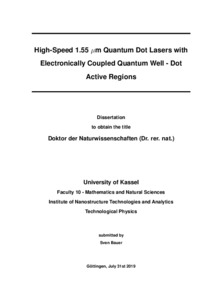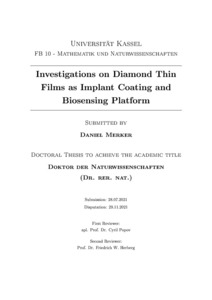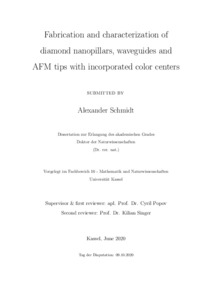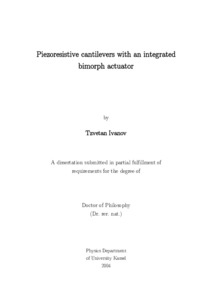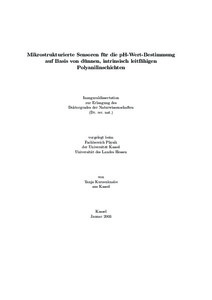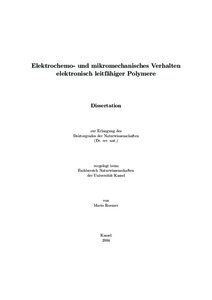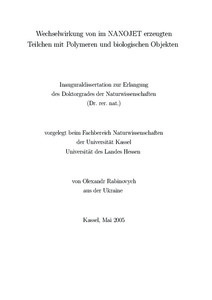Suche
Anzeige der Dokumente 1-10 von 23
Dissertation

 High-Speed 1.55 µm Quantum Dot Lasers with Electronically Coupled Quantum Well - Dot Active Regions
High-Speed 1.55 µm Quantum Dot Lasers with Electronically Coupled Quantum Well - Dot Active Regions
(2019-07-31)
The expansion of long-distance data communication at a wavelength of 1.55 µm calls for larger data transfer rates. Consequently, an improvement of emission and modulation properties of lasers emitting in this wavelength region is of high interest. The utilization of so-called tunnel-injection (TI) structures in InP-based quantum dot (QD) lasers is promising to fulfill this task. The aim of this thesis was the realization and analysis of TI structures in the lattice matched InP material system and incorporation into ...
Dissertation

 1.55 μm Quantum Dot Lasers for Telecommunication
1.55 μm Quantum Dot Lasers for Telecommunication
(2019)
The thesis at hand investigates the suitability of quantum dot (QD) material for use in long-distance coherent communication. The thesis was written in the frame of the SASER project MONOLOP that is aiming for a compact, monolithically integrated light source with a tunable wavelength covering the C+-band and narrow spectral linewidth below 500 kHz.
The thesis reviews the theoretical background of quantum dot material based on the InP material system and distributed feedback (DFB) lasers with lateral gratings as ...
Dissertation
 Investigation of diamond nanostructures with incorporated color centers
Investigation of diamond nanostructures with incorporated color centers
(2018)
Diamond is a material with excellent properties due to its structure and composition. Its crystal lattice is a perfect host of different defect centers, so-called color centers, whose properties, especially the capability of emitting single photons, can serve in quantum information technologies (QIT). As a high refractive index material only a small part of the photons emitted by these color centers in diamond can be collected. To enhance the photon collection efficiency photonic structures are necessary. They can ...
Dissertation

 Investigations on Diamond Thin Films as Implant Coating and Biosensing Platform
Investigations on Diamond Thin Films as Implant Coating and Biosensing Platform
(2021)
Diamond is researched in biological context for decades. Fundamental research has established diamond as a material that combines a pronounced compatibility with biological entities and resilience against even the harshest chemical and physical conditions. The present dissertation strives to improve the abilities of diamond in this matter even further by utilizing methods of nanostructuring and biochemical functionalization. Numerous characterization methods are used to monitor each step in detail and to evaluate the ...
Dissertation
 Fabrication and characterization of diamond nanopillars, waveguides and AFM tips with incorporated color centers
Fabrication and characterization of diamond nanopillars, waveguides and AFM tips with incorporated color centers
(2020-06)
Diamond is a unique material with outstanding properties and the perfect host for different crystal defects in its lattice, so-called color centers, which provide exceptional spin properties, rendering them a promising platform for the development of novel devices and components in quantum information technologies (QIT) and quantum sensing applications. To overcome diamond's high internal reflection due to its high refractive index, color centers need to be incorporated in photonic diamond structures, leading to ...
Dissertation
 Piezoresistive cantilevers with an integrated bimorph actuator
Piezoresistive cantilevers with an integrated bimorph actuator
(2004-07-26)
Scanning Probe Microscopy (SPM) has become of fundamental importance for research in area of micro and nano-technology. The continuous progress in these fields requires ultra sensitive measurements at high speed. The imaging speed limitation of the conventional Tapping Mode SPM is due to the actuation time constant of piezotube feedback loop that keeps the tapping amplitude constant. In order to avoid this limit a deflection sensor and an actuator have to be integrated into the cantilever. In this work has been ...
Dissertation
 Lithography-free micro- and nanostructuring based on conventional plasma etching
Lithography-free micro- and nanostructuring based on conventional plasma etching
(2005-02-02)
In now-a-days semiconductor and MEMS technologies the photolithography is the working horse for fabrication of functional devices. The conventional way (so called Top-Down approach) of microstructuring starts with photolithography, followed by patterning the structures using etching, especially dry etching. The requirements for smaller and hence faster devices lead to decrease of the feature size to the range of several nanometers. However, the production of devices in this scale range needs photolithography equipment, ...
Dissertation
 Mikrostrukturierte Sensoren für die pH-Wert-Bestimung auf Basis von dünnen, intrinisch leitfähigen Polyanilinschichten
Mikrostrukturierte Sensoren für die pH-Wert-Bestimung auf Basis von dünnen, intrinisch leitfähigen Polyanilinschichten
(2005-02-02)
Der pH-Wert stellt in der Chemie, Physik, Biologie, Pharmazie und Medizin eine wichtige Meßgröße dar, da eine Vielzahl von Reaktionen durch den pH-Wert bestimmt wird. In der Regel werden zur pH-Wert-Messung Glaselektroden eingesetzt. Hierbei konnte der pH-sensitive Bereich zwar bis auf einige Mikrometer reduziert werden, aber die Gesamtab-messungen betragen immer noch 15-20 cm. Mit der Einführung miniaturisierter Reaktionsgefäße ist daher der Bedarf an miniaturisierten Sensoren enorm gestiegen. Um in solchen Gefäßen ...
Dissertation
 Elektrochemo- und mikromechanisches Verhalten elektronisch leitfähiger Polymere
Elektrochemo- und mikromechanisches Verhalten elektronisch leitfähiger Polymere
(2004-11-22)
Intrinsisch leitfähige Polymere sind durch eine Reihe materialspezifischer Eigenschaften gekennzeichnet. In Abhängigkeit des angelegten Potenzials und der chemischen Umgebung zeigen sie elektrochromes Verhalten, Veränderungen der Masse, des Volumens und der elektronischen Leitfähigkeit. Basierend auf diesen Eigenschaften eignen sich halbleitende organische Polymere als funktionales Material für Anwendungen in der Mikro- und Nanotechnologie, insbesondere für miniaturisierte chemische Sensoren und Aktoren. Im Gegensatz ...
Dissertation
 Wechselwirkung von im NANOJET erzeugten Teilchen mit Polymeren und biologischen Objekten
Wechselwirkung von im NANOJET erzeugten Teilchen mit Polymeren und biologischen Objekten
(2005-06-08)
Am Institut für Mikrostrukturtechnologie und Analytik wurde eine neue Technik entwickelt, die neue Anwendungen und Methoden der Mikro- und Nanostrukturierung auf Basis eines neuen Verfahrens erschlossen hat. NANOJET führt über die passive Rastersondenmikroskopie hinaus zu einem vielseitigen, aktiven Bearbeitungswerkzeug auf der Mikro- und Nanometerskala. NANOJET (NANOstructuring Downstream PlasmaJET) ist eine aktive Rasterkraft-Mikroskopie-Sonde. Radikale (chemisch aktive Teilchen, die ein ungepaartes Valenzelektron ...

